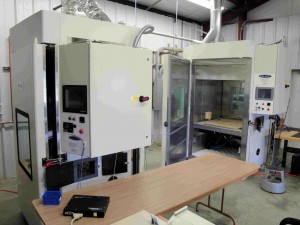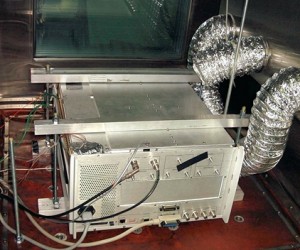HALT Chambers

Specialized test chambers are needed to perform a HALT. Typical HALT chambers are shown in Figure 1. The specification for HALT chambers is typically the following:
Liquid nitrogen (LN2) is used to cool the air temperature in HALT chambers. This allows for very rapid temperature changes of 60°C per minute and a cold temperature extreme of -100°C.
HALT chamber heating is provided by high power resistive heating elements that can produce changes of 60°C per minute and a hot temperature limit of +200°C.
HALT chambers produce random vibration in 6 DOF simultaneously using pneumatic air hammers attached to the bottom of the chamber table. This means random vibration energy is applied simultaneous along three orthogonal translations and three rotations which is very unique to HALT chambers. Sometimes the vibration produced in HALT is called repetitive shock because pneumatic air hammers are used to produce vibration.
Random vibration accelerations up to 60 Grms and frequency content to 10,000 Hz are common. It is important to understand how the how HALT chambers compute Grms. DES’s HALT chambers calculate Grms using a 5 kHz bandwidth. Some chamber manufactures use a 10 kHz bandwidth which approximately doubles the computed Grms, but in reality the resultant vibrations are about the same! More information about random vibration can be found in our blog article Sinusoidal and Random Vibration Testing Primer
It is important that HALT chambers can be run in automatic or manual modes of operation. Temperature and vibration profiles are programmed to run automatically during parts of the HALT procedure. This allows the temperature rate of change to be accurately controlled during temperature transitions. The chamber can also be run in manual mode with the operator controlling the temperature and vibration set points. This is useful for other parts of the HALT procedure such as when operational or destruct limits are being determined.
Fixtures
DES’s has many stock channel fixtures that can be used for products with a flat top and bottom. Examples of DES’s stock channel fixtures are shown in Figure 2.

Custom-designed fixtures can be fabricated on a case by case basis. Figure 3 shows examples of custom-designed test fixtures. The fixtures must have a flat base with holes to enable them to be bolted to the chamber vibration table. Customers or DES can supply the fixtures used to attach the test units to the vibration table inside the chamber.

When performing HALT, it is desired to change the temperature of internal components as fast as possible. If products have existing vent holes or cooling fans, then air ducts can be placed to blow air through them as seen in Figure 2. Products with a sealed enclosure or case should be modified whenever possible to allow for internal airflow. This can be done by removing covers when practical or drilling holes in the enclosure. Air ducts can then be placed near these openings to direct air flow internally into the product.
Instrumentation and Monitoring
Monitoring can be accomplished with either digital recording instruments or by manually recording gauge readings or by visual observations. Monitoring sensors are usually thermocouples and vibration accelerometers. Reference thermocouples are placed at various locations on the product to measure the response temperatures on the product. Also, during the vibration step part of the HALT procedure, reference vibration accelerometers can be placed on the product to measure its vibration response. Therefore a digital temperature data recorder is needed and a vibration spectrum analyzer or Grms recorder is useful. HALT chambers will typically provide basic digital recording of the chamber temperature and table Grms. DES provides the equipment for recording all of the temperatures and vibrations. Many times the customer provides the equipment for monitoring the specific performance of their product. However, DES has the capability to provide all of the monitoring equipment and instrumentation if desired. DES has extensive experience in setting up custom monitoring to record many different parameters such as voltage, current, pressure, etc.
Thanks for sharing this informative post!
environmental test chamber
Altitude chamber
Salt spray chamber